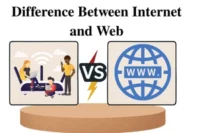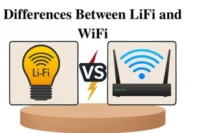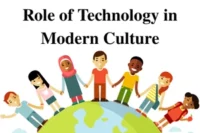What is Digital Technology: Explore its Applications, Pros & Cons and Future Trends
Published: 4 Aug 2025
In today’s rapidly changing environment, digital technology is everywhere. It influences the way we live, work, and communicate. But what exactly defines digital technology?
Simply expressed, it refers to tools, devices, and systems that use data in a particular format known as binary (0s and 1s) to do tasks. Consider your smartphone, social media applications, and even technological devices at home; they all utilize digital technology!
Digital technology is significant because it has transformed how organizations operate and individuals connect all over the world. It has improved many aspects of life, including healthcare, education, entertainment, and even how we deal with our money.
In this article, we’ll dive into what digital technology is, how it works, and why it’s so important for our daily lives. We’ll also look at its benefits, challenges, and how the applications of technology is shaping the future.
What is Digital Technology?
Simple Definition:
Digital technology means using electronic tools and devices to handle information. It works by turning data into a special format made up of 0s and 1s. This digitalized technology lets computers and other devices understand and use that information. Whether it’s text, images, sound, or video, digital technology helps convert it into a form that computers can process.
Technical Aspects:
Digital technology encompasses both hardware (computers, phones, and storage devices) and software (apps, websites, and programs). These tools collaborate to store, manage, and distribute information. The internet, wireless networks, and cloud services are all essential components of digital technology.
They enable devices to communicate with one another and share information in a timely and secure manner.
Practical Life Examples:
We see digital technology all around us. Here are a few examples:
- Smartphones: These devices let us call, text, browse the web, and use apps. These are examples of digital tech.
- Social Media: Platforms like Facebook and Instagram let us connect with friends and share pictures.
- Digital Cameras: Instead of using film, digital cameras capture and store images as data.
- Cloud Storage: Services like Google Drive store files online so we can access them from anywhere.
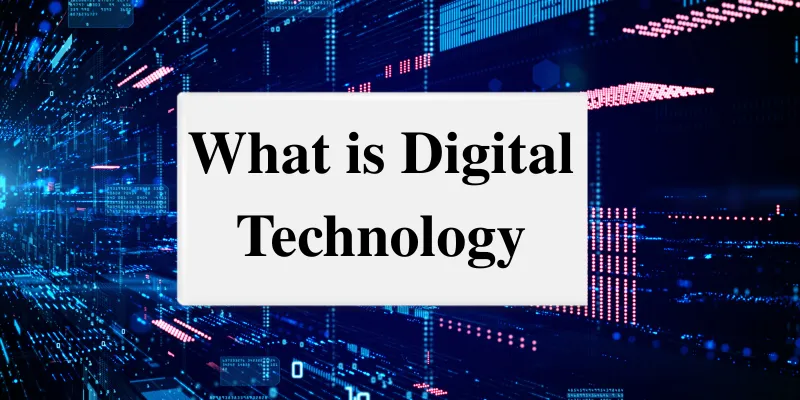
How Does Digital Technology Work?
Digital technology works by using a special language called binary code. This code is made up of just two numbers: 0 and 1. These numbers are the building blocks of all digital data. Let’s take a closer look at the basic working of digital technology.
- Binary Code, Bits, and Bytes
- Data Processing in Digital Devices
- Data Transmission and Communication
Binary Code, Bits, and Bytes
Binary Code: Binary code is the language that computers, smartphones, and other digital devices comprehend. It simply uses integers like 0s and 1s, also known as bits, to represent various types of information such as text, photos, sounds, and movies.
Bits: Bits are the smallest units of data. A bit can be either zero or one. When you combine bits, they may represent more complicated information. For example, a byte is made up of eight bits.
Bytes: They are made up of eight bits. This is the fundamental unit of storage in a digital system. A byte can represent a single character, such as the letter “A.” In binary, “A” is represented as 01000001.
Data Processing in Digital Devices
Computers, cellphones, and tablets use bits and bytes for data processing and save data. Here’s a simple explanation of how data processing occurs:
- Input: When you type on your phone or computer, the system converts your actions into binary code. For example, when you press the “A” key, it turns into the binary code for “A.”
- Processing: The central processing unit (CPU) is like the brain of the device. It takes all of the binary data, does the calculations and judgments, and converts it into something usable. For example, when you play a movie, the CPU analyzes the data and displays it on the screen.
- Storage: Digital systems store information in places like hard drives or cloud storage. All the data is kept in binary form, so it can be accessed whenever you need it.
- Output: After processing the input, the CPU produces visible or audible output. For example, the computer converts binary code into text on a screen or audio from speakers.
Data Transmission and Communication
Digital technology also facilitates communication between devices. This happens across networks such as the Internet or Bluetooth. Data is transmitted in little packets of binary data that go from one device to another. When these packets arrive at their destination, the system converts them back into the data that you require.
Real-Life Examples:
Imagine you send a picture to your friend using your phone. Here’s how it works:
- You take a photo, and your phone turns it into binary code.
- The phone sends the data through the internet in small packets.
- Your friend’s phone receives the packets and turns them back into the picture.
- They see the picture on their phone’s screen.
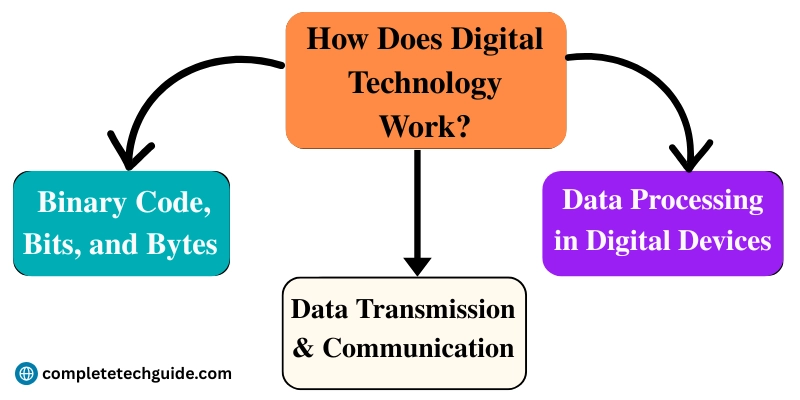
Real-World Applications of Digital Technology
Digital technology is ubiquitous and has a significant influence on many aspects of life. In many different kinds of sectors, it is used to simplify, accelerate, and improve efficiency. Here are a few examples of how digital technology is transforming our world:
- Healthcare
- Education
- Finance
- Retail and E-Commerce
- Entertainment
- Agriculture
- Government and Public Services
Healthcare
- Telemedicine: Doctors can now check and treat patients over video calls, which is especially helpful for people in remote areas.
- Electronic Health Records (EHRs): Doctors can store and share patient information digitally, making it easier to give the right treatment quickly.
- Robotic Surgery: Robots controlled by digital technology assist surgeons in performing surgeries with more precision, resulting in faster recovery times.
- Wearable Health Tech: Devices like smartwatches track your health data, such as heart rate and sleep patterns, helping people stay healthier.
Education
- E-Learning Platforms: Websites and applications allow students to learn from anywhere. They can complete courses, attend classes, and collaborate with others online.
- Virtual Classrooms: Platforms like Zoom and Google Classroom help teachers and students connect, no matter where they are.
- Gamification: Educational games make studying enjoyable and interactive, assisting students in disciplines such as arithmetic and linguistics.
Finance
- Online Banking and Mobile Payments: People may conveniently manage their money and pay for purchases using apps such as PayPal and Apple Pay on their phones.
- Cryptocurrency: Digital currencies such as Bitcoin, are altering the way people exchange money and providing a new method to handle finances.
- Robo-Advisors: These AI tools help people manage their money by providing investment advice and retirement plans.
Retail and E-Commerce
- Online Shopping: Websites such as Amazon allow consumers to buy practically anything from the comfort of their own homes with a few clicks.
- Personalized Shopping: Retailers utilize data to recommend items based on your preferences, making shopping easier and more enjoyable.
- Augmented Reality (AR) Shopping: Apps from businesses like IKEA allow you to virtually test things before purchasing them, such as viewing how a piece of furniture would appear in your space.
Entertainment
- Streaming Services: Platforms like Netflix and Spotify let you instantly watch movies or listen to music from anywhere.
- Virtual Reality (VR) and Augmented Reality (AR): VR and AR are utilized in gaming and entertainment to create immersive experiences that combine real-world and digital aspects.
- Social Media: Platforms such as YouTube and Instagram enable consumers to produce effortlessly and share material, affecting trends and enjoyment.
Agriculture
- Precision Farming: Drones and sensors allow farmers to cultivate crops more effectively by monitoring soil and weather conditions.
- Farm Management Software: Farmers use digital systems to track when to plant, wash, and harvest crops, increasing productivity.
Government and Public Services
- E-Government Services: Many governments now provide online services such as paying taxes or renewing permits, making it easier for people to get what they need.
- Smart Cities: Digital technology is utilized to improve city life by controlling traffic, monitoring energy use, and keeping streets safe.
Benefits of Digital Technology
Digital technology has made a huge impact on how we live, work, and interact. It brings many benefits that make our lives easier and more efficient. Let’s take a look at some of the advantages of digital technology:
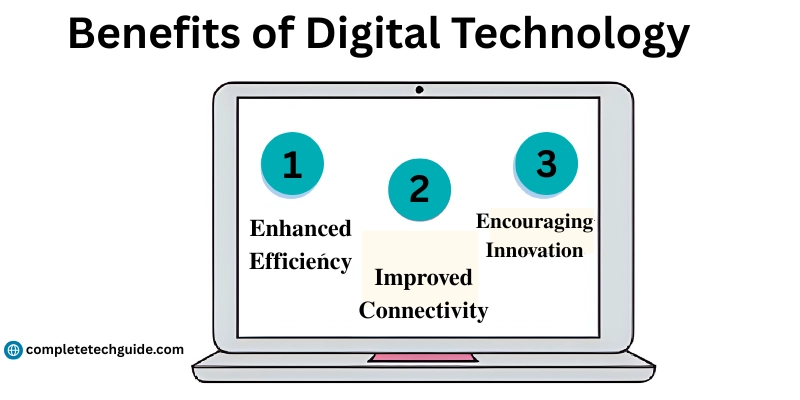
- Enhanced Efficiency
- Improved Connectivity
- Encouraging Innovation
Enhanced Efficiency
- Automation of Tasks: Digital technology is capable of handling repetitive duties such as customer service management and tracking of supplies. This saves time and allows individuals to focus on more vital tasks.
- Faster Processes: Transactions, document exchange, and communication can all be completed more quickly using digital technologies, which speeds up the process and reduces expenses.
- Error Reduction: Digital systems eliminate errors. For example, software may assist in preventing mistakes in calculations or record keeping, making everything more dependable.
Improved Connectivity
- Global Communication: Email, video calls (Zoom, Teams), and instant messaging enable individuals to interact and collaborate from anywhere in the world.
- Remote Work and Learning: Cloud platforms allow you to work or study from home. This was notably useful during the COVID-19 epidemic, keeping businesses and schools open.
- Social Media and Networking: Platforms such as Facebook, LinkedIn, and Twitter enable people to connect, exchange ideas, and communicate with others all over the world.
Encouraging Innovation
- New Business Models: Digital technology has given businesses new ways to operate. For example, e-commerce sites like Amazon and sharing economy applications like Uber have transformed established industries.
- Accelerated Product Development: Tools like 3D printing and simulation software help businesses create and test new products faster and more affordably.
- AI and Machine Learning: Artificial intelligence facilitates data analysis, prediction, and the development of new solutions. In healthcare, AI aids in medication discovery and therapy personalization, whereas in finance, it detects fraud.
Challenges and Considerations of Digital Technology
While digital technology offers many benefits, it also brings some challenges. These issues can affect society, security, and the environment. Let’s take a look at some of the disadvantages of technology on virtual use:
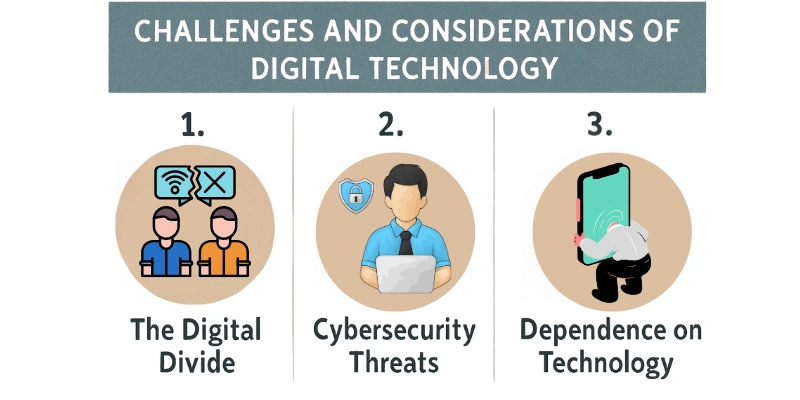
The Digital Divide
- Access to Technology: Not everyone has equal access to digital devices and the internet. People in rural locations or with lesser incomes do not always have the same access to technology as those in cities or affluent communities.
- Impact on Education and Jobs: Students who do not have access to the internet or modern technology risk falling behind in school. People who lack these tools find it more difficult to get work or obtain services.
- Bridging the Gap: Efforts are being made to address this, such as providing inexpensive internet access, distributing low-cost gadgets, and teaching digital skills so that everyone may benefit from technology.
Cybersecurity Threats
- Data Breaches and Hacks: As we keep more personal and business information online, the danger of cyberattacks increases. Hackers may steal critical information, disrupt services, or inflict economic damage.
- Privacy Concerns: Many companies acquire personal information for a variety of purposes, including enhancing services and tailoring advertisements. If this information is not safeguarded, it may lead to identity theft or privacy issues.
Dependence on Technology
- Over-Reliance on Digital Systems: People gradually rely on digital technology for everything from communication to entertainment. This dependence on technology can result in less face-to-face engagement and may make people feel isolated.
- Balancing Technology Use: It’s crucial to strike a balance. Take pauses from your screens, engage with others in person, and be mindful of the dangers of over-reliance on digital technology.
The Future of Digital Technology
Digital technology is changing fast, and it’s going to keep growing in exciting ways. New technologies are shaping the future and changing how we live, work, and play.
Let’s look at some of the latest trends of technology that will shape the future of digital tech:
Artificial Intelligence (AI) and Machine Learning
- Advanced Automation: AI and machine learning are already making life simpler by automating jobs. In the future, AI will aid in areas such as tailored healthcare, self-driving cars, and smart cities, where everything operates smoothly with minimal human effort.
- AI in Creativity: AI is also finding its way into the artistic sectors. It supports artists, musicians, and designers by generating ideas and even producing material. In the future, AI might collaborate with humans to develop new forms of art and entertainment.
5G and Beyond: The Next Generation of Connectivity
- Faster Internet: 5G networks will provide ultrafast internet speeds, up to 100 times faster than 4G. This will make video streaming, gaming, and internet chatting more efficient and seamless.
- 6G and Future Connectivity: In the future, 6G will speed things up even further. It might introduce cutting-edge technology such as holographic video calls and improved virtual reality.
Quantum Computing
Supercharged Computers: Quantum computers will be far quicker than those we use now. They can tackle issues that are too complicated for traditional computers. This might transform areas such as healthcare, security, and science.
Virtual Reality (VR) and Augmented Reality (AR)
VR and AR will revolutionize how we interact with the world. VR transports us to a completely new universe, whereas AR adds digital information to the actual environment. These technologies will make educational, healthcare, and commerce experiences more enjoyable and interactive.
Biotechnology and Digital Health
- Wearable Health Tech: Smartwatches and other technologies will track our health, allowing us to stay healthy and possibly detect ailments early. These gadgets will provide clinicians with real-time information to improve care.
- Gene Editing and Personalized Medicine: CRISPR technology will enable doctors to treat diseases based on our DNA, making therapies more effective and individualized.
Conclusion
Digital technology has transformed everything. It affects how we live, work, and interact with others. The benefits are obvious, ranging from assisting doctors in saving lives to making learning more accessible. It accelerates, smartens, and optimizes processes. Technology is transforming healthcare, education, cities, and the environment.
Looking ahead, emerging technologies such as artificial intelligence, quantum computing, and blockchain will accelerate progress even faster.
These devices will aid in the resolution of large-scale concerns ranging from health to climate change. They will open up new prospects for enterprises, communities, and individuals throughout the world.
What do you think? How do you see digital technology changing your life in the future? Let’s keep exploring together!

- Be Respectful
- Stay Relevant
- Stay Positive
- True Feedback
- Encourage Discussion
- Avoid Spamming
- No Fake News
- Don't Copy-Paste
- No Personal Attacks



- Be Respectful
- Stay Relevant
- Stay Positive
- True Feedback
- Encourage Discussion
- Avoid Spamming
- No Fake News
- Don't Copy-Paste
- No Personal Attacks


